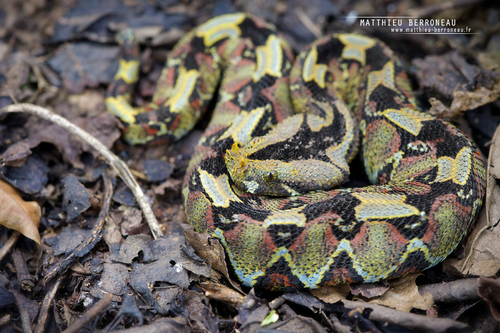
Rhinoceros Viper
The rhinoceros viper's vibrant patterns and horned snout make it a captivating rainforest dweller. Known for its ambush hunting technique and powerful venom, this snake plays a crucial role in controlling rodent populations. Its unique appearance and behavior highlight the incredible diversity of African ecosystems.
8 years
Lifespan
Length: 1.2192 m
Size
Multi-colored
Color
Medium
Aggression
Vulnerable
Conservation Status
Decreasing
Population Trend
Characteristics
Bitis nasicornis, commonly known as the rhinoceros viper, is renowned for its striking coloration and unique horn-like scales on its snout. This venomous snake inhabits the dense, humid rainforests of Central and West Africa. It is a master of camouflage, often lying motionless among the leaf litter, waiting to ambush prey. Its potent venom and distinct hissing sound serve as formidable defenses.
Distribution Range of the Rhinoceros Viper
Bitis nasicornis, commonly known as the Rhinoceros Viper, is native to the rainforests and swamps of West and Central Africa. Its geographical distribution includes countries such as Nigeria, Cameroon, Gabon, the Democratic Republic of the Congo, and Uganda. It is primarily found within the lowland tropical rainforests, where it thrives in the lush, humid environments.
Rhinoceros Viper's Habitat
Environmental Conditions
Bitis nasicornis inhabits dense, humid rainforests and swampy areas. It prefers environments with high humidity, abundant foliage, and consistent rainfall. The climate within these regions is typically equatorial, characterized by high temperatures averaging between 24°C to 28°C (75°F to 82°F) and significant annual rainfall, often exceeding 2000 mm (78 inches).
Ecological Niche
As an ambush predator, the Rhinoceros Viper occupies a niche as a ground-dwelling snake that uses its cryptic coloration to blend with the forest floor. It primarily preys on small mammals, birds, and amphibians. Its habitat is often in proximity to water sources like streams and rivers, which support its prey base and provide ideal conditions for its survival. Variations in habitat can occur due to regional adaptations, where some populations may be found in slightly drier forest edges or degraded forest environments.
Copyright @ Nature Style Limited. All Rights Reserved.
 English
English